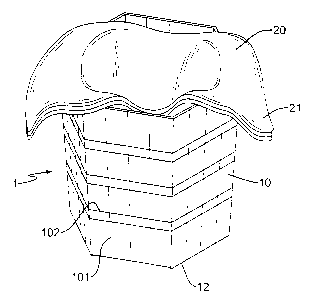Some of the information on this Web page has been provided by external sources. The Government of Canada is not responsible for the accuracy, reliability or currency of the information supplied by external sources. Users wishing to rely upon this information should consult directly with the source of the information. Content provided by external sources is not subject to official languages, privacy and accessibility requirements.
Any discrepancies in the text and image of the Claims and Abstract are due to differing posting times. Text of the Claims and Abstract are posted:
| (12) Patent Application: | (11) CA 2502910 |
|---|---|
| (54) English Title: | RECYCLING TRASH CAN |
| (54) French Title: | POUBELLE A RECYCLAGE |
| Status: | Deemed Abandoned and Beyond the Period of Reinstatement - Pending Response to Notice of Disregarded Communication |
| (51) International Patent Classification (IPC): |
|
|---|---|
| (72) Inventors : |
|
| (73) Owners : |
|
| (71) Applicants : |
|
| (74) Agent: | BATTISON WILLIAMS DUPUIS |
| (74) Associate agent: | |
| (45) Issued: | |
| (22) Filed Date: | 2005-03-31 |
| (41) Open to Public Inspection: | 2006-09-30 |
| Availability of licence: | N/A |
| Dedicated to the Public: | N/A |
| (25) Language of filing: | English |
| Patent Cooperation Treaty (PCT): | No |
|---|
| (30) Application Priority Data: | None |
|---|
A recycling trash can includes a body (10), a top open end and a bottom open
end. The body (10) is made of cardboard and provided with a closed side wall
and
having multiple longitudinal seams (101) and latitudinal seams (102) formed on
an
outer periphery of the body (10) to allow the body (10) to be folded to be
compact. The
bottom open end has multiple bends (12) formed on a peripheral edge of the
bottom
open end and each bend (12) being separated from one another via a gap (121)
defined
between two adjacent bends (12). Each bend (12) is attachable to an adjacent
bend (12)
via an adhesive agent (13) applied to each of the bends.
Note: Claims are shown in the official language in which they were submitted.
Note: Descriptions are shown in the official language in which they were submitted.

2024-08-01:As part of the Next Generation Patents (NGP) transition, the Canadian Patents Database (CPD) now contains a more detailed Event History, which replicates the Event Log of our new back-office solution.
Please note that "Inactive:" events refers to events no longer in use in our new back-office solution.
For a clearer understanding of the status of the application/patent presented on this page, the site Disclaimer , as well as the definitions for Patent , Event History , Maintenance Fee and Payment History should be consulted.
| Description | Date |
|---|---|
| Application Not Reinstated by Deadline | 2008-03-31 |
| Time Limit for Reversal Expired | 2008-03-31 |
| Deemed Abandoned - Failure to Respond to Maintenance Fee Notice | 2007-04-02 |
| Application Published (Open to Public Inspection) | 2006-09-30 |
| Inactive: Cover page published | 2006-09-29 |
| Inactive: IPC assigned | 2005-05-27 |
| Inactive: First IPC assigned | 2005-05-27 |
| Application Received - Regular National | 2005-05-05 |
| Filing Requirements Determined Compliant | 2005-05-05 |
| Inactive: Filing certificate - No RFE (English) | 2005-05-05 |
| Abandonment Date | Reason | Reinstatement Date |
|---|---|---|
| 2007-04-02 |
| Fee Type | Anniversary Year | Due Date | Paid Date |
|---|---|---|---|
| Application fee - small | 2005-03-31 |
Note: Records showing the ownership history in alphabetical order.
| Current Owners on Record |
|---|
| CHI-CHEN HOU |
| Past Owners on Record |
|---|
| None |